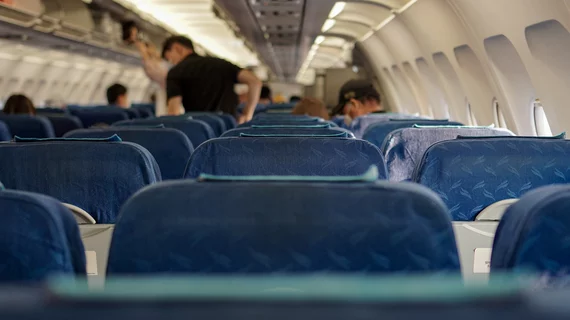Is there a radiologist on board? Why imaging providers must prepare for in-flight medical emergencies
As countries begin to ease their COVID-19 restrictions, travel will likely pick up. And radiologists must be prepared to take action when a mid-flight medical emergency springs up, experts argued in a new report.
Nearly 4 billion passengers fly commercially around the world each year (pre-pandemic figures) and in-flight medical emergencies are relatively common, totaling around 44,000 annually.
Rads don’t often utilize their hands-on clinical skills learned during medical school, and asking them to perform life-support without their usual equipment and years out of an internship is “incredibly challenging,” researchers explained May 1 in Clinical Imaging.
“Therefore, the ability to familiarize the radiologist with in-flight emergencies should not only improve physician competency and comfort in managing such situations, but it may result in improved in-flight patient outcomes,” Sean D. Raj, MD, of UT Southwestern Medical Center’s Department of Radiology, and colleagues added.
What resources might radiologists have on board?
The Federal Aviation Administration mandates a set of crucial medical supplies be available during flights.
Radiologists should have access to basic life-support equipment, such as an automated external defibrillator and supplies for intravenous access. Other medications including epinephrine, lidocaine and antihistamine are also supplied.
Additionally, most airlines have access to medical personnel on the ground who are trained in emergency situations or telemedicine.
Common in-flight emergencies
In all situations, radiologists and other physicians should take a general approach to care. This includes introducing yourself and stating your qualifications to flight staff, the patient and family. Gaining consent to treat and obtaining a medical history should follow. Documenting everything that took place is also important.
Out of all in-flight medical emergencies, fainting or syncope is the most common, accounting for about 35% of cases. Changing cabin air pressure is the likely culprit, Raj et al. suggested
Other more common run-ins include gastrointestinal emergencies, strokes, allergic reactions and psychiatric problems. Of the latter, nearly one-quarter are related to alcohol, the authors noted.
Less common emergencies typically have unfavorable outcomes and include cardiac arrest (less than 1% of cases), acute coronary syndrome, respiratory problems and infectious diseases.
Legal and ethical concerns
A physician will be on board about 85% of flights, but such providers volunteer in less than half of medical emergencies. The reluctance is at least in part due to a fear of liability, Raj and co-authors noted.
In many countries, including the U.S. and Canada, intervening is entirely voluntary. Other regions, such as Europe, require providers to accept care. A 1988 U.S. law does protect individuals who aid in most emergency situations unless serious negligence can be proven.
At the same time, there is also an ethical component to this discussion, as well as a question of preparedness, the authors argued.
“Although many specialties maintain preparedness for direct patient encounters, several other specialties may lack frequent direct patient contact in an emergency setting,” the group explained. “Given this, consideration should be given to whether there is a duty to refresh knowledge and clinical skills in such situations periodically.”
Read much more from this review, published in Clinical Imaging here.

